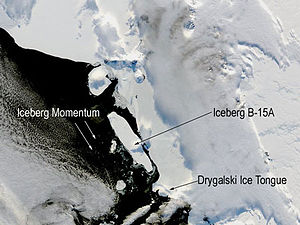Iceberg B-15


Iceberg B-15 was the world's largest recorded iceberg, with an area of over 11,000 km². It calved from the Ross Ice Shelf in March 2000, breaking up into several pieces in 2002 and 2003. The largest of these, B-15A, was the world's largest free-floating object—it was 122 km (76 miles) long, 27 km (17 miles) wide, and covered an area of 3,100 km² (1,200 mile², or approximately the size of Luxembourg). In November 2003, after the separation from B-15J iceberg, B-15A drifted away from Ross Island on the open waters of the Ross Sea. In December 2003 a small knife-shaped iceberg, B-15K (about 300 km²), detached itself from the main body of B-15A and started drifting northward. In 2005 prevailing currents took B-15A slowly past the Drygalski ice tongue; the collision broke off the tip of Drygalski in mid-April. Then the iceberg sailed on along the coast leaving McMurdo Sound until it ran aground off Cape Adare in Victoria Land and broke into several smaller pieces on 27–28 October 2005. The largest piece is still named B-15A (its surface is now approx. 1700 km²), while three additional pieces were named B-15P, B-15M and B-15N.
Effect on Antarctic ecology
On 10 April 2005 B-15A impacted the Drygalski ice tongue, a projection of the fast-moving David Glacier that flows through Antarctica's mountainous Victoria Land coastal region, breaking off an 8-km² (3-mi²) section of the ice tongue. This collision with the Drygalski tongue forced a redrawing of Antarctic maps. B-15A prevented ocean currents and winds from assisting in the 2004–2005 summer break-up of the sea ice in McMurdo Sound, and was an obstacle to the annual resupply ships to three research stations. The floe was expected to cause a catastrophic decline in the population of Adelie Penguins, as it added considerable distances which parent penguins must travel back from the sea to their chicks. Weddell seals and Skuas are also inhabitants of McMurdo Sound and their populations may have been affected as well.

References
- ESA satellite monitoring, updated frequently
See also
External links
- Situation around Balleby Islands; Icebergs B-15A, B-15N, C-19A, ESA MERIS Level 1 Selected Image, 2 March 2006.
- Envisat shows behemoth B-15A iceberg breaking up, ESA News, 7 November 2005.
- Pile-up as berg hits Antarctica, BBC News Online, 19 April 2005.
- World's Largest Floating Object Free Again, Livescience.com, 18 March 2005.
- Huge Iceberg heading for collision, TV New Zealand, 13 January 2005.
- Get Ready for the Largest Demolition Derby on the Planet, NASA, 6 January 2005.
- The Iceberg Cometh, The Guardian, 15 December 2004.
- NASA Earth Observatory images, November - December 2004
- Outta the Way, It's B15a! Light-hearted, layman's look at the world's largest iceberg by Roderick Eime.
